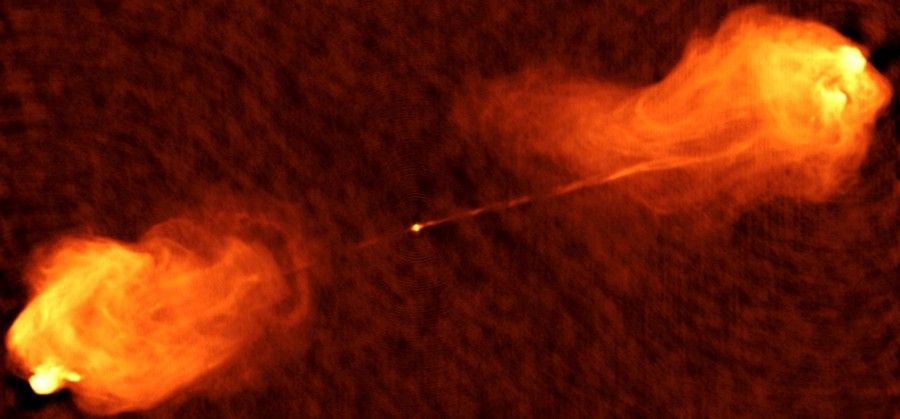By Rafi Letzter - Staff Writer 14 hours ago
It existed just 900 million years after the Big Bang.

This radio image shows two jets shooting out of the center of Cygnus A, a galaxy not too far from our own. A new paper reports discovering a similar object in a much more distant, ancient galaxy. That galaxy has a bright, relatavistic jet emanating from its central supermassive black hole pointed at Earth, making it a blazar.
(Image: © NRAO)
Nine hundred million years after the Big Bang, in the epoch of our universe's earliest galaxies, there was already a black hole 1 billion times the size of our sun. That black hole sucked in huge quantities of ionized gas, forming a galactic engine — known as a blazar — that blasted a superhot jet of bright matter into space. On Earth, we can still detect the light from that explosion more than 12 billion years later.
Astronomers had previously discovered evidence of primeval supermassive black holes in slightly younger "radio-loud active galactic nuclei," or RL AGNs. RL AGNs are galaxies with cores that look extra-bright to radio telescopes, which is considered evidence that they contain supermassive black holes. Blazars are a unique type of RL AGN that spit out two narrow jets of "relativistic" (near-light-speed) matter in opposite directions. Those jets emit narrow beams of light at many different wavelengths and have to be pointed right at Earth for us to detect them across such vast distances. This new blazar discovery moves the date of the oldest confirmed supermassive black hole to within the first billion years of the universe's history and suggests there were other, similar black holes in that era that we haven't detected.
"Thanks to our discovery, we are able to say that in the first billion years of life of the universe, there existed a large number of very massive black holes emitting powerful relativistic jets," Silvia Belladitta, a doctoral student at the Italian National Institute for Astrophysics (INAF) in Milan and co-author of a new paper on the blazar, said in a statement.
More:
https://www.livescience.com/early-universe-black-hole-blazar-galaxy-discovey.html
No comments:
Post a Comment